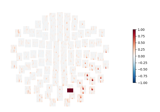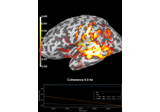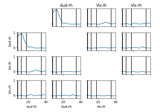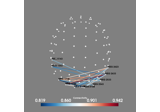mne.connectivity.spectral_connectivity¶
- mne.connectivity.spectral_connectivity(data, method='coh', indices=None, sfreq=6.283185307179586, mode='multitaper', fmin=None, fmax=inf, fskip=0, faverage=False, tmin=None, tmax=None, mt_bandwidth=None, mt_adaptive=False, mt_low_bias=True, cwt_freqs=None, cwt_n_cycles=7, block_size=1000, n_jobs=1, verbose=None)[source]¶
Compute frequency- and time-frequency-domain connectivity measures.
The connectivity method(s) are specified using the “method” parameter. All methods are based on estimates of the cross- and power spectral densities (CSD/PSD) Sxy and Sxx, Syy.
- Parameters
- dataarray_like, shape=(n_epochs, n_signals, n_times) |
Epochs The data from which to compute connectivity. Note that it is also possible to combine multiple signals by providing a list of tuples, e.g., data = [(arr_0, stc_0), (arr_1, stc_1), (arr_2, stc_2)], corresponds to 3 epochs, and arr_* could be an array with the same number of time points as stc_*. The array-like object can also be a list/generator of array, shape =(n_signals, n_times), or a list/generator of SourceEstimate or VolSourceEstimate objects.
- method
str|listofstr Connectivity measure(s) to compute.
- indices
tupleofarray|None Two arrays with indices of connections for which to compute connectivity. If None, all connections are computed.
- sfreq
float The sampling frequency.
- mode
str Spectrum estimation mode can be either: ‘multitaper’, ‘fourier’, or ‘cwt_morlet’.
- fmin
float|tupleoffloat The lower frequency of interest. Multiple bands are defined using a tuple, e.g., (8., 20.) for two bands with 8Hz and 20Hz lower freq. If None the frequency corresponding to an epoch length of 5 cycles is used.
- fmax
float|tupleoffloat The upper frequency of interest. Multiple bands are dedined using a tuple, e.g. (13., 30.) for two band with 13Hz and 30Hz upper freq.
- fskip
int Omit every “(fskip + 1)-th” frequency bin to decimate in frequency domain.
- faveragebool
Average connectivity scores for each frequency band. If True, the output freqs will be a list with arrays of the frequencies that were averaged.
- tmin
float|None Time to start connectivity estimation. Note: when “data” is an array, the first sample is assumed to be at time 0. For other types (Epochs, etc.), the time information contained in the object is used to compute the time indices.
- tmax
float|None Time to end connectivity estimation. Note: when “data” is an array, the first sample is assumed to be at time 0. For other types (Epochs, etc.), the time information contained in the object is used to compute the time indices.
- mt_bandwidth
float|None The bandwidth of the multitaper windowing function in Hz. Only used in ‘multitaper’ mode.
- mt_adaptivebool
Use adaptive weights to combine the tapered spectra into PSD. Only used in ‘multitaper’ mode.
- mt_low_biasbool
Only use tapers with more than 90% spectral concentration within bandwidth. Only used in ‘multitaper’ mode.
- cwt_freqs
array Array of frequencies of interest. Only used in ‘cwt_morlet’ mode.
- cwt_n_cycles
float|arrayoffloat Number of cycles. Fixed number or one per frequency. Only used in ‘cwt_morlet’ mode.
- block_size
int How many connections to compute at once (higher numbers are faster but require more memory).
- n_jobs
int How many epochs to process in parallel.
- verbosebool,
str,int, orNone If not None, override default verbose level (see
mne.verbose()and Logging documentation for more). If used, it should be passed as a keyword-argument only.
- dataarray_like, shape=(n_epochs, n_signals, n_times) |
- Returns
- con
array|listofarray Computed connectivity measure(s). The shape of each array is either (n_signals, n_signals, n_freqs) mode: ‘multitaper’ or ‘fourier’ (n_signals, n_signals, n_freqs, n_times) mode: ‘cwt_morlet’ when “indices” is None, or (n_con, n_freqs) mode: ‘multitaper’ or ‘fourier’ (n_con, n_freqs, n_times) mode: ‘cwt_morlet’ when “indices” is specified and “n_con = len(indices[0])”.
- freqs
array Frequency points at which the connectivity was computed.
- times
array Time points for which the connectivity was computed.
- n_epochs
int Number of epochs used for computation.
- n_tapers
int The number of DPSS tapers used. Only defined in ‘multitaper’ mode. Otherwise None is returned.
- con
Notes
The spectral densities can be estimated using a multitaper method with digital prolate spheroidal sequence (DPSS) windows, a discrete Fourier transform with Hanning windows, or a continuous wavelet transform using Morlet wavelets. The spectral estimation mode is specified using the “mode” parameter.
By default, the connectivity between all signals is computed (only connections corresponding to the lower-triangular part of the connectivity matrix). If one is only interested in the connectivity between some signals, the “indices” parameter can be used. For example, to compute the connectivity between the signal with index 0 and signals “2, 3, 4” (a total of 3 connections) one can use the following:
indices = (np.array([0, 0, 0]), # row indices np.array([2, 3, 4])) # col indices con_flat = spectral_connectivity(data, method='coh', indices=indices, ...)
In this case con_flat.shape = (3, n_freqs). The connectivity scores are in the same order as defined indices.
Supported Connectivity Measures
The connectivity method(s) is specified using the “method” parameter. The following methods are supported (note:
E[]denotes average over epochs). Multiple measures can be computed at once by using a list/tuple, e.g.,['coh', 'pli']to compute coherence and PLI.‘coh’ : Coherence given by:
| E[Sxy] | C = --------------------- sqrt(E[Sxx] * E[Syy])
‘cohy’ : Coherency given by:
E[Sxy] C = --------------------- sqrt(E[Sxx] * E[Syy])
‘imcoh’ : Imaginary coherence 1 given by:
Im(E[Sxy]) C = ---------------------- sqrt(E[Sxx] * E[Syy])
‘plv’ : Phase-Locking Value (PLV) 2 given by:
PLV = |E[Sxy/|Sxy|]|
‘ciplv’ : corrected imaginary PLV (icPLV) 3 given by:
|E[Im(Sxy/|Sxy|)]| ciPLV = ------------------------------------ sqrt(1 - |E[real(Sxy/|Sxy|)]| ** 2)
‘ppc’ : Pairwise Phase Consistency (PPC), an unbiased estimator of squared PLV 4.
‘pli’ : Phase Lag Index (PLI) 5 given by:
PLI = |E[sign(Im(Sxy))]|
‘pli2_unbiased’ : Unbiased estimator of squared PLI 6.
‘wpli’ : Weighted Phase Lag Index (WPLI) 6 given by:
|E[Im(Sxy)]| WPLI = ------------------ E[|Im(Sxy)|]
‘wpli2_debiased’ : Debiased estimator of squared WPLI 6.
References
- 1
Guido Nolte, Ou Bai, Lewis Wheaton, Zoltan Mari, Sherry Vorbach, and Mark Hallett. Identifying true brain interaction from EEG data using the imaginary part of coherency. Clinical Neurophysiology, 115(10):2292–2307, 2004. doi:10.1016/j.clinph.2004.04.029.
- 2
Jean-Philippe Lachaux, Eugenio Rodriguez, Jacques Martinerie, and Francisco J. Varela. Measuring phase synchrony in brain signals. Human Brain Mapping, 8(4):194–208, 1999. doi:10.1002/(SICI)1097-0193(1999)8:4<194::AID-HBM4>3.0.CO;2-C.
- 3
Ernesto Pereda Ricardo Bruña, Fernando Maestú. Phase locking value revisited: teaching new tricks to an old dog. Journal of Neural Engineering, 15(5):056011, 2018. doi:10.1088/1741-2552/aacfe4.
- 4
Martin Vinck, Marijn van Wingerden, Thilo Womelsdorf, Pascal Fries, and Cyriel M.A. Pennartz. The pairwise phase consistency: a bias-free measure of rhythmic neuronal synchronization. NeuroImage, 51(1):112–122, 2010. doi:10.1016/j.neuroimage.2010.01.073.
- 5
Cornelis J. Stam, Guido Nolte, and Andreas Daffertshofer. Phase lag index: assessment of functional connectivity from multi channel EEG and MEG with diminished bias from common sources. Human Brain Mapping, 28(11):1178–1193, 2007. doi:10.1002/hbm.20346.
- 6(1,2,3)
Martin Vinck, Robert Oostenveld, Marijn van Wingerden, Franscesco Battaglia, and Cyriel M.A. Pennartz. An improved index of phase-synchronization for electrophysiological data in the presence of volume-conduction, noise and sample-size bias. NeuroImage, 55(4):1548–1565, 2011. doi:10.1016/j.neuroimage.2011.01.055.





